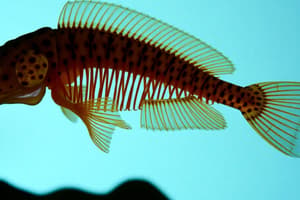Podcast
Questions and Answers
All animals are multicellular.
All animals are multicellular.
True (A)
All animals exhibit the same pattern of organization.
All animals exhibit the same pattern of organization.
False (B)
Sponges exhibit the tissue level of organization.
Sponges exhibit the tissue level of organization.
False (B)
The organ level of organization is exhibited by members of Platyhelminthes.
The organ level of organization is exhibited by members of Platyhelminthes.
Animals are grouped together to form organs based on their specific function.
Animals are grouped together to form organs based on their specific function.
What are the fundamental features common to various individuals of animals in relation to their arrangement of cells, body symmetry, nature of coelom, patterns of digestive, circulatory or reproductive systems?
What are the fundamental features common to various individuals of animals in relation to their arrangement of cells, body symmetry, nature of coelom, patterns of digestive, circulatory or reproductive systems?
What is the difference between the cellular level and the tissue level of organization?
What is the difference between the cellular level and the tissue level of organization?
Flashcards
Cellular Level of Organization
Cellular Level of Organization
The most basic level of organization in animals, where cells are loosely grouped together. Think of a sponge—it has simple cells, but no tissues.
Tissue Level of Organization
Tissue Level of Organization
A more complex level of organization where similar cells group together to form tissues, which perform specific tasks. Imagine a coral, with its tissues forming a colony.
Organ Level of Organization
Organ Level of Organization
The most advanced level of organization, where tissues combine to create organs, each with a specialised function. Think of a worm, with its organs like a digestive system.
Characteristics of Cellular Level of Organization
Characteristics of Cellular Level of Organization
Signup and view all the flashcards
Characteristics of Tissue Level of Organization
Characteristics of Tissue Level of Organization
Signup and view all the flashcards
Characteristics of Organ Level of Organization
Characteristics of Organ Level of Organization
Signup and view all the flashcards
Classification
Classification
Signup and view all the flashcards
Importance of Classification
Importance of Classification
Signup and view all the flashcards
Taxonomy
Taxonomy
Signup and view all the flashcards
Basis of Classification
Basis of Classification
Signup and view all the flashcards
Level of Organization
Level of Organization
Signup and view all the flashcards
Body Symmetry
Body Symmetry
Signup and view all the flashcards
Coelom
Coelom
Signup and view all the flashcards
Digestive System
Digestive System
Signup and view all the flashcards
Circulatory System
Circulatory System
Signup and view all the flashcards
Study Notes
Animal Classification
- Animal classification is crucial for understanding the diversity of animals and assigning a systematic position to newly described species.
- Different animals have different structures and forms.
Basis of Classification
- Fundamental features common to various animals are used for animal classification
- Cell arrangement
- Body symmetry
- Digestive, circulatory, or reproductive systems
Levels of Organisation
- All animals in Animalia are multicellular
- Different animals exhibit varying levels of cell organisation
- Cellular level: Cells are loosely arranged (e.g., sponges)
- Tissue level: Cells performing similar functions are grouped into tissues (e.g., coelenterates)
- Organ level: Tissues are grouped to form organs with specific functions (e.g., Platyhelminthes)
Studying That Suits You
Use AI to generate personalized quizzes and flashcards to suit your learning preferences.




